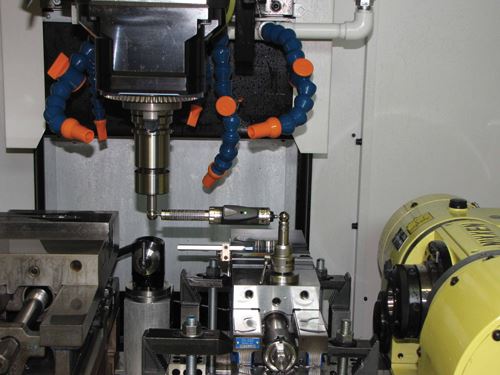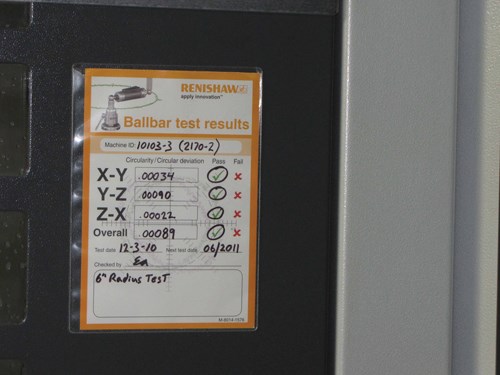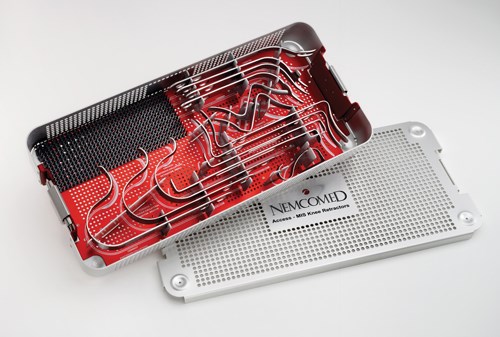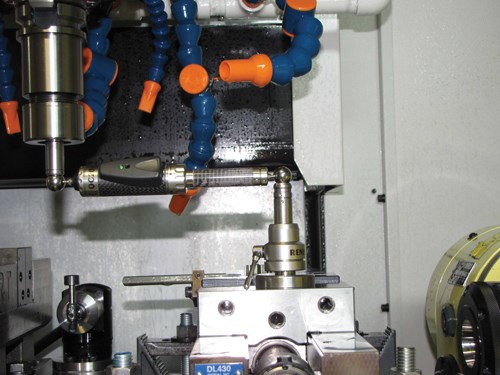Ballbar analysis is generally regarded as a practical, convenient method for assessing CNC machine contouring accuracy. Although ballbars have been commonplace at precision machining operations for more than 20 years, the experience of medical device manufacturer Nemcomed suggests that one recently unveiled model has even more to offer. According to the company, the QC20-W wireless ballbar from Renishaw (Hoffman Estates, Illinois) has made a big difference in performing fast capability checks on smaller machines and in establishing a benchmark on machines’ volumetric accuracy.
Nemcomed, a division of Avalign Technologies, is a Fort Wayne, Indiana-based supplier of medical implants and instrumentation to orthopedic OEMs. The company manufactures more than 1,000 different parts, including implants for knees, hips, shoulders, wrists, elbows, fingers and the spine, as well as tools such as pliers and wire cutters. Most are produced from stainless steel, titanium or cobalt chrome in lot sizes of 30 to 40 pieces. Raw material, typically barstock or forgings, goes to a cut-off cell before moving to a mill or turning center, depending on complexity.
Many of the implants have complex features, such as curved or spherical components, that require precise machining. Also, customers often have their own special requirements, and Nemcomed’s status as a medical device manufacturer requires compliance with such federal regulations as the FDA 21 CFR Part 820 Quality System Regulation and the ISO 13485 Medical Device Standard. As a result, ensuring that machine tools and processes are capable of producing parts to spec is a critical concern. “We also have a personal interest and pride in knowing that our products may end up in someone’s body,” says Eric Arnold, manufacturing engineer at Nemcomed. “As potential patients ourselves someday, we want to make the highest-quality parts possible.”
Before purchasing the Renishaw QC20-W ballbar to qualify machines, the company used that device’s predecessor, the QC10. The new ballbar retains the previous model’s principle of using a CNC circular program and software to diagnose and quantify machine positioning errors involving servo mismatch, stick-slip, backlash, repeatability, scale mismatch and machine geometry. It also provides an overall circularity value.
However, new features unveiled with the QC20-W had an immediate, positive impact on both part quality and the bottom line when Nemcomed acquired the device in 2010, Mr. Arnold says. He notes that the previous, wired ballbar required three separate setups to test a machine’s X-Y, Y-Z and X-Z planes. This amounted to a
total setup time of about 1.5 hours. In contrast, the new model requires just one setup for testing in all three planes. Now, total setup time is less than 15 minutes. “More importantly, it doesn’t disturb our production setup, so we don’t have to reset the machine when we go back to production mode,” he adds. “We remove the ballbar, insert a tool and get back to making parts in minutes.”
Wireless operation is also especially useful for the company’s smaller machine tools. “Machine tool makers understand how much lean operations value floor space, so the new machine tools are designed with smaller footprints,” Mr. Arnold explains. “This results in less interior space to maneuver a wired ballbar, so wireless data transmission is a big advantage.” He adds that the ability to fully close machine doors during testing, which would be impossible with a wired ballbar, improves safety.
In addition, the new ballbar design’s ability to test in three orthogonal planes through a single reference point with a single setup enables the accompanying software to produce a representative measurement of volumetric positioning accuracy by correlating all three. This benchmark of volumetric accuracy is valuable for Nemcomed because positioning errors can be compounded by simultaneous multi-axis motion during contouring, Mr. Arnold says. Volumetric accuracy is also important with large machine volumes and parts because toolpath deviation is amplified across longer machine travels.
The ballbar’s potential for both fast and accurate machine tests became apparent shortly after purchasing the system, when a machine went out-of-spec. In addition to testing the machine with the ballbar, the company ordered a laser interferometer test. The results were identical, and this level of accuracy soon contributed to the acquisition of a large, quality-focused customer that required verification of machine calibration. “The expense of bringing in the laser inter-ferometer for every machine would have made it cost-prohibitive to supply this customer with parts,” Mr. Arnold says. “We showed the customer the results of the ballbar and interferometer tests, and they agreed that ballbar testing would meet their verification requirements. Basically, the QC20-W paid for itself after testing just two machines.”
As part of the company’s predictive maintenance program, maintenance engineers track a three-month timeframe of results. This helps detect errors early and improves efficiency in scheduling maintenance and repairs, Mr. Arnold says. He adds that a system case with storage for various accessories makes the ballbar easy to transport to any of the company’s four global manufacturing facilities, set up quickly and obtain needed machine qualifications.
In August 2010, Nemcomed completed a 10,000-square-foot addition to its Fort Wayne plant in order to consolidate another plant’s operations and add space for new machines. That brought the number of machines tested with the ballbar to 20. November brought another 14,000-square-foot expansion, and as Nemcomed continues to grow, its use of the ballbar will grow as well, Mr. Arnold says. “Knowing the machine’s capability before it cuts parts enables us to minimize scrap and machine downtime. That gives us high part quality and productivity while keeping manufacturing cost low. It’s what lean manufacturing is all about—greater customer value.”































.jpg;maxWidth=300;quality=90)









